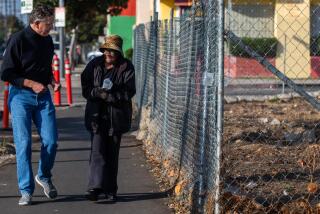Simi Valley’s Bottle Village Gets Chance to Shine
- Share via
A Simi Valley folk-art landmark made largely with bottles that once contained everything from milk to milk of magnesia is one step closer to reopening as a museum within the next year.
The City of Simi Valley ordered the deteriorating Bottle Village closed to the public because of unsafe conditions in 1982.
But the collection of 13 buildings and 20 sculptures built from empty bottles, license plates, scraps of tile and almost anything else Tressa (Grandma) Prisbrey could haul back from the city dump was granted a long-sought special-use permit last week by the Simi Valley Planning Commission.
3-Year Effort
Obtaining the permit was a major step in a three-year effort by a group called the Preserve Bottle Village Committee to reopen the cluttered site and make it a folk-art museum.
The group saved Bottle Village from the bulldozer by buying the Cochran Street property from a developer in 1982. But the city soon ordered it closed because of exposed wiring and rickety walls in buildings made of bottles embedded in concrete.
Complying with the permit will require about $100,000 worth of remodeling, not to mention a good dusting, said Joanne Johnson, restoration coordinator for the committee.
“Grandma would have a fit if she saw this,” Johnson said, pointing to the layer of dirt on a row of 1950s television picture tubes. Prisbrey, now 91, has been living in a San Francisco convalescent home in recent years.
Johnson said Prisbrey, 5 feet, 2 inches tall and weighing about 100 pounds, single-handedly built Bottle Village over three decades, although no one has figured out exactly how or why. “She had a tremendous amount of energy,” she said.
Year of Repair
The restoration committee now has a year under the permit to repair the structures and a number of other things, including the signs, and upgrade the landscaping and parking, said Frank Brutt, director of the Simi Valley Department of Community Development.
The committee hopes some of the money it needs will come through grants from arts and historical foundations, Johnson said.
Inside the small dwellings at Bottle Village, the late afternoon light filters through the glass and “it’s like a cathedral,” Johnson said. “When it rains, it sparkles,” she said, and when the wind blows across the tops of the bottles, “it’s the singing bottle village.”
The site has often has been compared to Simon Rodia’s Watts Towers, another Southern California folk-art landmark made of refuse.
When Grandma Prisbrey began building Bottle Village around her trailer home in 1956, the area was mostly an expanse of farmland. Now it is a working-class neighborhood, and condominiums are being built next door.
‘To Each His Own’
John Wigert, 57, who has lived next to Bottle Village for 10 years, said, “A lot of neighbors don’t like it; it’s an eyesore, they say.” He said he has never been to the village, adding, “To each his own.”
“It’s not art if it’s not controversial,” said Johnson, who calls Bottle Village “a folk-art environment.”
The most controversial item, she said, is the “doll-head planter.” It consists of broomsticks and pipes sticking out of the ground, with rotted doll heads impaled on them.
“It looks like something out of Stephen King,” she said, looking down at the torso of a Ken doll. From its head, resting a few inches away, dead blue eyes stared up from the dirt.
At one time, another planter displayed more conventional tastes, after a daughter of Prisbrey’s asked for a rose garden and Prisbrey planted one there, Johnson said. According to the story, the day the daughter died, the roses did too, and Grandma replaced them with sticks supporting milk of magnesia bottles.
Some of those bottles, and some of the automobile headlights in the concrete around them, were smashed in March by vandals, Johnson said.
More to Read
Sign up for Essential California
The most important California stories and recommendations in your inbox every morning.
You may occasionally receive promotional content from the Los Angeles Times.












